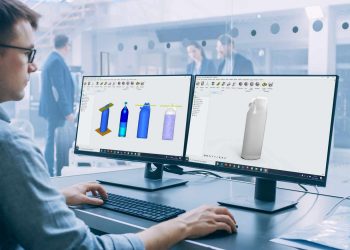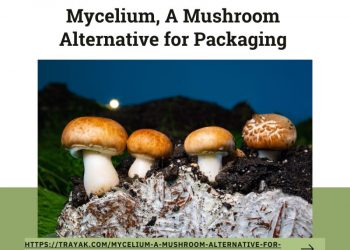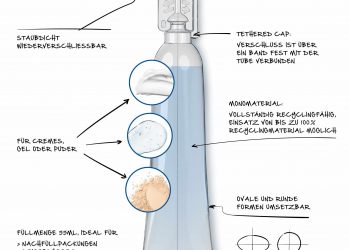Introduction
Bio-based polymers are materials which are produced from renewable resources. The terms bio-based polymers and biodegradable polymers are used extensively in the literature, but there is a key difference between the two types of polymers.
Biopolymers are of two main types: biopolymers that come from living organisms; and, biopolymers which need to be polymerized but come from renewable resources. Both types are used in the production of bioplastics. Biopolymers that are present in, or created by, living organisms include carbohydrates and proteins. These can be used in the production of bioplastic for commercial purposes.
Molecules from renewable natural resources can be polymerized to be used in the manufacture of biodegradable plastics.
Biodegradable polymers are defined as materials whose physical and chemical properties undergo deterioration and completely degrade when exposed to microorganisms, carbon dioxide (aerobic) processes, methane (anaerobic processes), and water (aerobic and anaerobic processes). Bio-based polymers can be biodegradable (e.g., Polylactic acid) or non-degradable (e.g., biopolyethylene). Similarly, while many bio-based polymers are biodegradable (e.g., starch and polyhydroxyalkanoates), not all biodegradable polymers are bio-based (e.g., polycaprolactone).
Analysis of the Biopolymer Market
Challenges in bridging the Synthetic Polymer-Biopolymer Gap
Approximately 99% of all plastics are produced or derived from the major non-renewable energy sources, including natural gas, naphtha, crude oil, and coal, which are used as both feedstock material and energy source in plastics manufacturing. For some time, agricultural materials have been considered as an alternate feedstock and source of energy for plastics production but have fallen short of expectations for more than a decade. The main hindrance to the use of plastics from agricultural based feedstocks has been cost and product functionality limitations (starch product sensitivity to humidity, polyhdroxybutrates brittleness), as well as lack of flexibility in producing specialized plastics materials.
A confluence of factors, volatility of oil prices, worldwide interest in renewable resources, growing concern regarding greenhouse gas emissions and a new emphasis on waste management has created renewed interest in biopolymers and bioplastics and the efficiency with which they can be produced. New technologies in plant breeding and processing are narrowing the bioplastics-synthetic plastics cost differential, as well as improving material properties (Biomer for example is developing PHB grades with higher melt strength for blown film). Mounting environmental concerns and legislative incentives, particularly in the EU, have stimulated interest in biodegradable plastics (bioplastics). Implementation of the Kyoto Protocol will also bring into sharper focus the relative performance of biopolymers and synthetics in terms of their respective energy use and CO2 emissions. As a rule of thumb, starch-based plastics (bioplastics) can save between 0.8 and 3.2 tons of CO2 per ton compared to one ton of fossil fuel-derived plastic, the range reflecting the share of petroleum based copolymers used in the plastic. For oil seed based plastic alternatives greenhouse gases emissions savings in CO2 equivalents has been estimated to be 1.5 tons per ton of polyol made from rapeseed oil. Bio-based polymers still hold a tiny fraction of the total global plastic market. Currently, biopolymers share less than 1% of the total market.
The worldwide interest in bio-based polymers has accelerated in recent years due to the desire and need to find non-fossil fuel-based polymers. As indicated by ISI Web of Sciences and Thomas Innovations, there is a tremendous increase in the number of publication citations on bio-based polymers and applications in recent years.
Bio-based polymers offer important contributions by reducing the dependence on fossil fuels and through the related positive environmental impacts such as reduced carbon dioxide emissions. The legislative landscape is also changing where bio-based products are being favored through initiatives such as the Lead Market Initiative (European Union) and BioPreferred (USA). As a result, there is a worldwide demand for replacing petroleum-derived raw materials with renewable resource-based raw materials for the production of polymers.
The first generation of bio-based polymers focused on deriving polymers from agricultural feedstocks such as corn, potatoes, and other carbohydrate feedstocks. However, the focus has shifted in recent years due to a desire to move away from food-based resources and significant breakthroughs in biotechnology.
Bio-based polymers similar to conventional polymers are produced by bacterial fermentation processes by synthesizing the building blocks (monomers) from renewable resources, including lignocellulosic biomass (starch and cellulose), fatty acids, and organic waste. Natural bio-based polymers are the other class of bio-based polymers which are found naturally, such as proteins, nucleic acids, and polysaccharides (collagen, chitosan, etc.). These bio-based polymers have shown enormous growth in recent years in terms of technological developments and their commercial applications.
The Road Ahead for Global Biopolymer Market
The global market for plastics over the next 10 years is expected to continue the rapid growth experienced over the last fifty years. Experts in the field believe that that in this time frame, bioplastics could conservatively capture between 1.5 and 4.8% of the total plastics market bringing the world biopolymer market to between 4 million and 12.5 million tons, depending on the level of R&D applied to developing new bioplastics resins. By 2020, Toyota officials expect one-fifth of the world’s plastic will be bioplastic, equivalent to 30 million tons.
Consumption data broadly vary with sources, depending on the concept of bioplastics, a certain confusion between consumption and production capacity, the retained data for partially bio-polymers, the retained global economy hypotheses and the optimism of the forecaster.
Total Bio-PET consumption data can be affected by a reduction factor taking into account the low bio-content, 30%, leading to the new rating showed in Table 4.
In both cases, bio-polymers based on bio-monomers or bio-blocks account for more than 50%.
Green PE: A Success Story
Pioneer in the development of PE made from sugar cane ethanol, Braskem is World Leader with an annual capacity of 200 KT. First commercial scale production was launched in September 2010.
Braskem’s Green PE is claimed:
• To be processed on the same equipment as oil-based PE
• Having similar properties to oil-based PE
• Recyclable
• Decreasing the greenhouse effect and global warming as it absorbs more CO2 from the atmosphere than it emits throughout its production cycle – from the cutlivation of sugarcane to final PE resins.
Bio-PE helps capture and sequester 2.5 tons of CO2 for each ton produced.
Bio-PET: A Marketing Argument Developed by Steps
Three steps are considered:
• In a first step, fossil components are partially replaced by Bio-monomers.
• In a second step, fossil components are totally replaced by bio-monomers
• In a third step, PET is replaced by PEF (poly-ethylene-furanoate).
First Step: Plant-based Mono Ethylene Glycol
Coca-Cola launched innovative PlantBottle™ packaging technology based on recyclable PET beverage bottles made from up to 30 percent plant. Up to October 2012, Coca-Cola has sold more than 10 billion PlantBottle™ packages around the world. Since the package launched in 2009, its use has eliminated the equivalent of almost 100,000 metric tons of carbon dioxide emissions – the equivalent of 200,000 barrels of oil. The PET resin is made with bio-based monoethylene glycol.
To further push plant-based PET in end-use markets, Coca-Cola put together a partnership with Ford Motor, HJ Heinz, Nike and Procter & Gamble to spur the development and use of plant-based PET material and fibers. Toyota Tsusho Corp., among others, is also a global supplier of Bio-PET resin.
Second Step: Para-xylene for 100% Bio-polyester
The plastics industry currently uses p-xylene from petroleum as a precursor of phthalic acid. Virent Cy has successfully made paraxylene, named BioFormPX™, from 100% renewable plant sugars. When combined with existing PET technology, it allows companies to offer customers 100% natural, renewable, plant-based PET. University of Massachusetts Amherst has discovered a new, high-yield method of producing p-xylene from the biomass feedstock with an efficient yield of 75-percent.
The Third Way: PEF (Poly-ethylene-furanoate)
Dutch research and technology company Avantium has developed a patented technology YXY to produce 100% biobased PEF bottles. The company has announced an agreement with The Coca-Cola Company to further co-develop Avantium’s YXY technology for producing PEF bottles. Avantium has demonstrated that PEF has numerous superior properties over PET, including barrier properties (oxygen, carbon-dioxide and water) and ability to withstand heat. The YXY technology makes it possible to produce a 100% biobased and 100% recyclable polyester. Avantium is actively working on the development of PEF bottles for water, soft drinks, fruit juices, alcoholic drinks, food, diary, cosmetic products, soaps and detergents
Gevo has developed a 100 percent renewable isobutanol, which can be a building block for paraxylene.
Biopolymer Marketing Strategies
The development, clarification and application of an effective marketing strategy is the most important step for any firm planning a serious investment in biopolymers. While growth in the biopolymer industry is assured there are various factors to consider. Key issues impacting biopolymer marketing strategies and related production/R&D activities are:
• Choice of biopolymer market segment (packaging, agriculture, automotive, building, medical), geographic regions and target markets: Improved biopolymer processing technologies are enabling better control of macromolecular structures allowing new generations of ‘commodity’ polymers to challenge more expensive ‘specialty’ polymers. Additionally with new catalysts and improved control in polymerization, a new generation of specialty polymers for both functional and structural purposes is emerging generating new markets. Examples are biomedical applications for implants, dentistry and surgery which are growing rapidly.
• Core technologies for biopolymers: fermentation technologies; plant breeding; molecular science; the production of raw material for feedstock or energy or both; use of GMOs (genetically modified organisms) or non-GMOs in fermentation and biomass production.
• Degree of support from government policies and the general regulatory environment for biopolymers: Recycled plastics are to some extent competing with biodegradable polymers. Government regulations and legislation in respect to the environment and treatment of waste can be expected to have a growing effect on plastics sales for various resins. Implementaion of the Kyoto Protocol is likely to increase demand for certain biobased materials.
• Supply chain development in the fragmented biopolymer industry and the business implications of economies of scale versus a focus on products with superior attributes that can be sold at premium prices.
Biodegradable and Non-Petroleum Based Polymers
Environmental Impact Reducing Plastics
There are three major degradable polymer groups in the market. They are PHA or PHB, polylactides (PLA), and starch-based polymers. Other materials used commercially for degradable plastics are lignin, cellulose, polyvinyl alcohol, and poly-e-caprolactone. There are many producers who are manufacturing blends of degradable materials either to improve the properties of these materials or to reduce product costs.
PHB and its copolymers have been mixed with a variety of polymers, having very different characteristics; biodegradable and non-biodegradable, amorphous or crystalline with both different melting points and Tg in order to improve their processability and low impact resistance. Blends are also being used to improve PLA (biopolymer) properties. While normal PLAs behave much like a polystyrene exhibiting brittleness and low elongation to break, the addition of 10-15% Eastar Bio, a Novamont (formerly Eastman Chemical) biodegradable petroleum based polyester measurably improves ductility, with corresponding higher flexural modulus and impact strength as an example. To increase biodegradability, while simultaneously lowering the cost and preserving resources, it is possible to blend polymeric materials with natural products such as starches. Starch is a semicrystalline polymer composed of amylase and amylopectin with the ratios varying depending upon the plant source. As starch is hydrophilic, the use of compatibilizers can play a critical role in successfully blending this material with normally otherwise incompatible hydrophobic polymers.
Price Comparison
From a price comparison standpoint, existing petroleum based plastics are less costly than bioplastics or biopolymers. Currently from an overall price comparison standpoint, bioplastics are 2½ to 7½ times more expensive than traditional major petroleum based plastics. Yet, few years ago bioplastics were 35 to 100 times more expensive than existing non-renewable, fossil fuel based equivalents
Summary
Crude oil and natural gas are not renewable in a human time scale and at current consumption levels, known recoverable reserves would be dried up in approximately 30 to 100 years leading to a global energy crisis. Alternatives include, among other ways, the replacement of petroleum by the exploitation of biomass and CO2. The renewable biomass can be processed according to more or less complex treatments to transform it in a source of bio-monomers used as bio-blocks for conventional polymerization of bio-polymers.
References:
1. www.omnexus.com : January 2015
2. www.specialchem4polymers.com : October 2013
3. Various internet resources for news items & updates.
Packaging 360 is a comprehensive knowledge sharing ecosystem for the Indian packaging industry. Our services include an online content platform to deliver news, insights and case studies; organising conferences seminars and customised training; Providing Bespoke Project Consulting, Market Research and Intelligence.







